wheel torque CHEVROLET KODIAK 2009 Owners Manual
[x] Cancel search | Manufacturer: CHEVROLET, Model Year: 2009, Model line: KODIAK, Model: CHEVROLET KODIAK 2009Pages: 376, PDF Size: 5.39 MB
Page 280 of 376
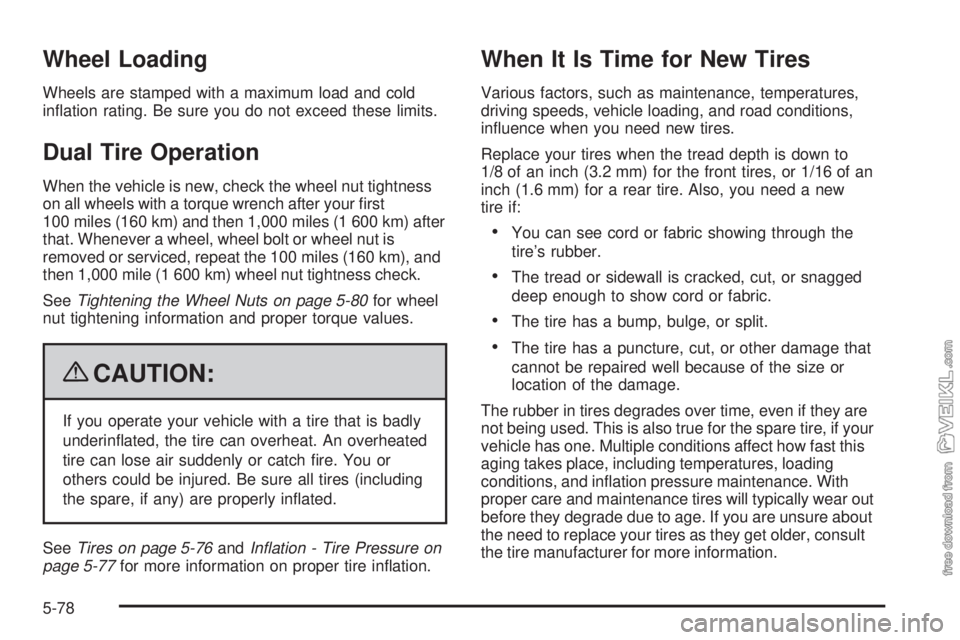
Wheel Loading
Wheels are stamped with a maximum load and cold
inflation rating. Be sure you do not exceed these limits.
Dual Tire Operation
When the vehicle is new, check the wheel nut tightness
on all wheels with a torque wrench after your first
100 miles (160 km) and then 1,000 miles (1 600 km) after
that. Whenever a wheel, wheel bolt or wheel nut is
removed or serviced, repeat the 100 miles (160 km), and
then 1,000 mile (1 600 km) wheel nut tightness check.
SeeTightening the Wheel Nuts on page 5-80for wheel
nut tightening information and proper torque values.
{CAUTION:
If you operate your vehicle with a tire that is badly
underinflated, the tire can overheat. An overheated
tire can lose air suddenly or catch fire. You or
others could be injured. Be sure all tires (including
the spare, if any) are properly inflated.
SeeTires on page 5-76andInflation - Tire Pressure on
page 5-77for more information on proper tire inflation.
When It Is Time for New Tires
Various factors, such as maintenance, temperatures,
driving speeds, vehicle loading, and road conditions,
influence when you need new tires.
Replace your tires when the tread depth is down to
1/8 of an inch (3.2 mm) for the front tires, or 1/16 of an
inch (1.6 mm) for a rear tire. Also, you need a new
tire if:
•You can see cord or fabric showing through the
tire’s rubber.
•The tread or sidewall is cracked, cut, or snagged
deep enough to show cord or fabric.
•The tire has a bump, bulge, or split.
•The tire has a puncture, cut, or other damage that
cannot be repaired well because of the size or
location of the damage.
The rubber in tires degrades over time, even if they are
not being used. This is also true for the spare tire, if your
vehicle has one. Multiple conditions affect how fast this
aging takes place, including temperatures, loading
conditions, and inflation pressure maintenance. With
proper care and maintenance tires will typically wear out
before they degrade due to age. If you are unsure about
the need to replace your tires as they get older, consult
the tire manufacturer for more information.
5-78
Page 285 of 376
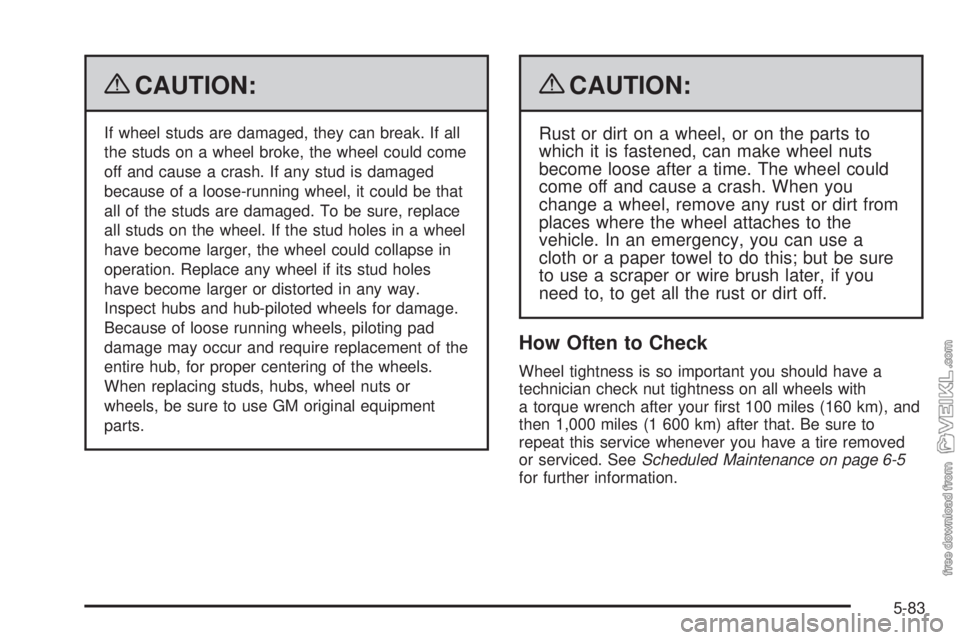
{CAUTION:
If wheel studs are damaged, they can break. If all
the studs on a wheel broke, the wheel could come
off and cause a crash. If any stud is damaged
because of a loose-running wheel, it could be that
all of the studs are damaged. To be sure, replace
all studs on the wheel. If the stud holes in a wheel
have become larger, the wheel could collapse in
operation. Replace any wheel if its stud holes
have become larger or distorted in any way.
Inspect hubs and hub-piloted wheels for damage.
Because of loose running wheels, piloting pad
damage may occur and require replacement of the
entire hub, for proper centering of the wheels.
When replacing studs, hubs, wheel nuts or
wheels, be sure to use GM original equipment
parts.
{CAUTION:
Rust or dirt on a wheel, or on the parts to
which it is fastened, can make wheel nuts
become loose after a time. The wheel could
come off and cause a crash. When you
change a wheel, remove any rust or dirt from
places where the wheel attaches to the
vehicle. In an emergency, you can use a
cloth or a paper towel to do this; but be sure
to use a scraper or wire brush later, if you
need to, to get all the rust or dirt off.
How Often to Check
Wheel tightness is so important you should have a
technician check nut tightness on all wheels with
a torque wrench after your first 100 miles (160 km), and
then 1,000 miles (1 600 km) after that. Be sure to
repeat this service whenever you have a tire removed
or serviced. SeeScheduled Maintenance on page 6-5
for further information.
5-83
Page 288 of 376
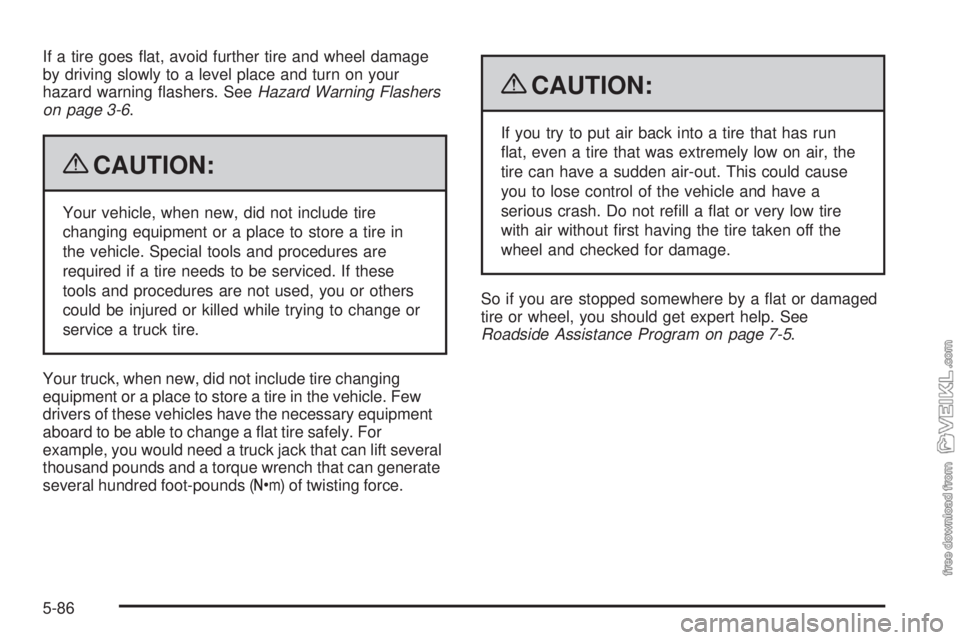
If a tire goes flat, avoid further tire and wheel damage
by driving slowly to a level place and turn on your
hazard warning flashers. SeeHazard Warning Flashers
on page 3-6.
{CAUTION:
Your vehicle, when new, did not include tire
changing equipment or a place to store a tire in
the vehicle. Special tools and procedures are
required if a tire needs to be serviced. If these
tools and procedures are not used, you or others
could be injured or killed while trying to change or
service a truck tire.
Your truck, when new, did not include tire changing
equipment or a place to store a tire in the vehicle. Few
drivers of these vehicles have the necessary equipment
aboard to be able to change a flat tire safely. For
example, you would need a truck jack that can lift several
thousand pounds and a torque wrench that can generate
several hundred foot-pounds (Y) of twisting force.
{CAUTION:
If you try to put air back into a tire that has run
flat, even a tire that was extremely low on air, the
tire can have a sudden air-out. This could cause
you to lose control of the vehicle and have a
serious crash. Do not refill a flat or very low tire
with air without first having the tire taken off the
wheel and checked for damage.
So if you are stopped somewhere by a flat or damaged
tire or wheel, you should get expert help. See
Roadside Assistance Program on page 7-5.
5-86
Page 337 of 376
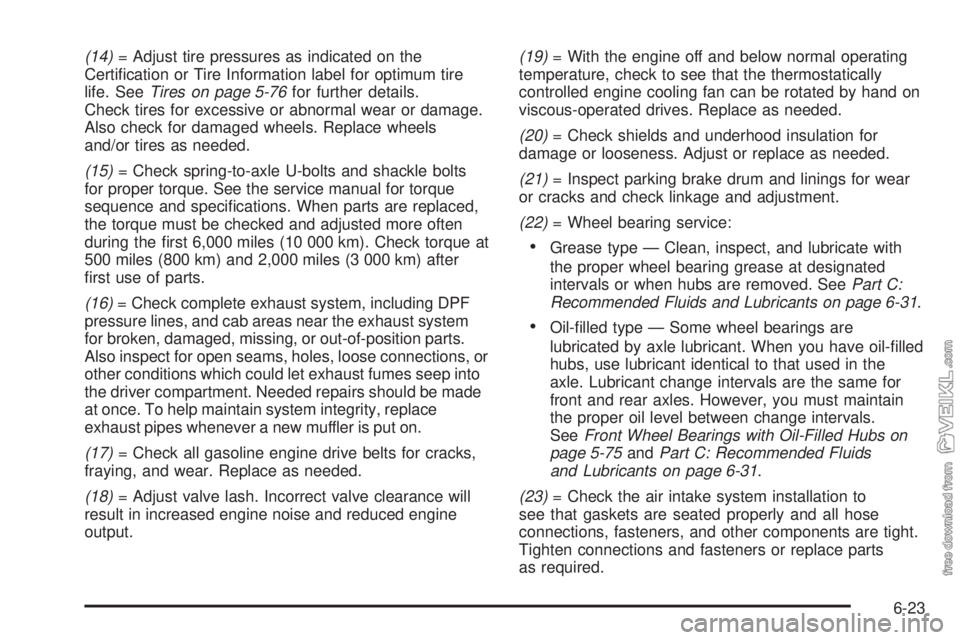
(14)= Adjust tire pressures as indicated on the
Certification or Tire Information label for optimum tire
life. SeeTires on page 5-76for further details.
Check tires for excessive or abnormal wear or damage.
Also check for damaged wheels. Replace wheels
and/or tires as needed.
(15)= Check spring-to-axle U-bolts and shackle bolts
for proper torque. See the service manual for torque
sequence and specifications. When parts are replaced,
the torque must be checked and adjusted more often
during the first 6,000 miles (10 000 km). Check torque at
500 miles (800 km) and 2,000 miles (3 000 km) after
first use of parts.
(16)= Check complete exhaust system, including DPF
pressure lines, and cab areas near the exhaust system
for broken, damaged, missing, or out-of-position parts.
Also inspect for open seams, holes, loose connections, or
other conditions which could let exhaust fumes seep into
the driver compartment. Needed repairs should be made
at once. To help maintain system integrity, replace
exhaust pipes whenever a new muffler is put on.
(17)= Check all gasoline engine drive belts for cracks,
fraying, and wear. Replace as needed.
(18)= Adjust valve lash. Incorrect valve clearance will
result in increased engine noise and reduced engine
output.(19)= With the engine off and below normal operating
temperature, check to see that the thermostatically
controlled engine cooling fan can be rotated by hand on
viscous-operated drives. Replace as needed.
(20)= Check shields and underhood insulation for
damage or looseness. Adjust or replace as needed.
(21)= Inspect parking brake drum and linings for wear
or cracks and check linkage and adjustment.
(22)= Wheel bearing service:
•Grease type — Clean, inspect, and lubricate with
the proper wheel bearing grease at designated
intervals or when hubs are removed. SeePart C:
Recommended Fluids and Lubricants on page 6-31.
•Oil-filled type — Some wheel bearings are
lubricated by axle lubricant. When you have oil-filled
hubs, use lubricant identical to that used in the
axle. Lubricant change intervals are the same for
front and rear axles. However, you must maintain
the proper oil level between change intervals.
SeeFront Wheel Bearings with Oil-Filled Hubs on
page 5-75andPart C: Recommended Fluids
and Lubricants on page 6-31.
(23)= Check the air intake system installation to
see that gaskets are seated properly and all hose
connections, fasteners, and other components are tight.
Tighten connections and fasteners or replace parts
as required.
6-23
Page 339 of 376
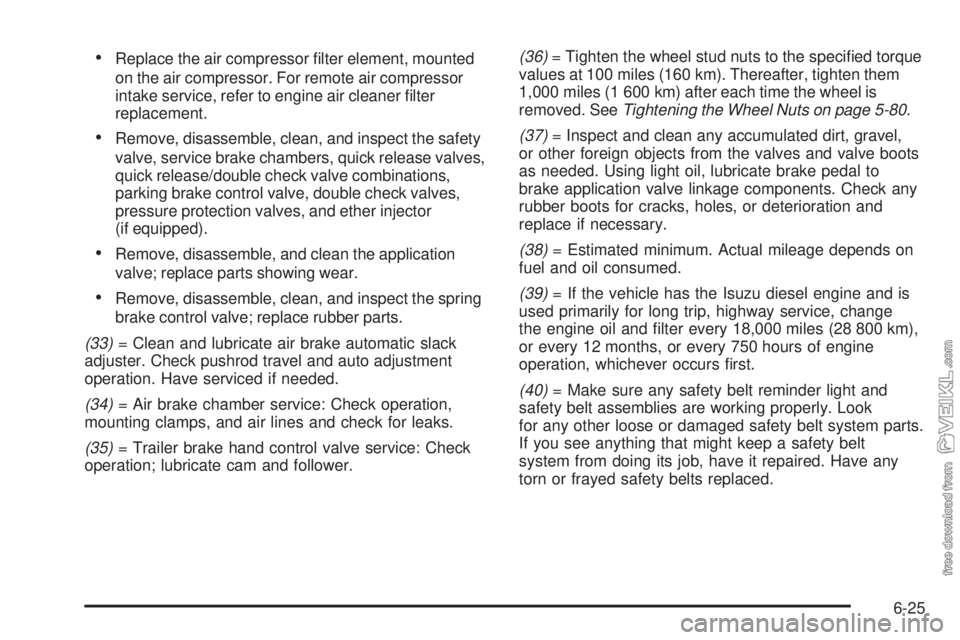
•Replace the air compressor filter element, mounted
on the air compressor. For remote air compressor
intake service, refer to engine air cleaner filter
replacement.
•Remove, disassemble, clean, and inspect the safety
valve, service brake chambers, quick release valves,
quick release/double check valve combinations,
parking brake control valve, double check valves,
pressure protection valves, and ether injector
(if equipped).
•Remove, disassemble, and clean the application
valve; replace parts showing wear.
•Remove, disassemble, clean, and inspect the spring
brake control valve; replace rubber parts.
(33)= Clean and lubricate air brake automatic slack
adjuster. Check pushrod travel and auto adjustment
operation. Have serviced if needed.
(34)= Air brake chamber service: Check operation,
mounting clamps, and air lines and check for leaks.
(35)= Trailer brake hand control valve service: Check
operation; lubricate cam and follower.(36)= Tighten the wheel stud nuts to the specified torque
values at 100 miles (160 km). Thereafter, tighten them
1,000 miles (1 600 km) after each time the wheel is
removed. SeeTightening the Wheel Nuts on page 5-80.
(37)= Inspect and clean any accumulated dirt, gravel,
or other foreign objects from the valves and valve boots
as needed. Using light oil, lubricate brake pedal to
brake application valve linkage components. Check any
rubber boots for cracks, holes, or deterioration and
replace if necessary.
(38)= Estimated minimum. Actual mileage depends on
fuel and oil consumed.
(39)= If the vehicle has the Isuzu diesel engine and is
used primarily for long trip, highway service, change
the engine oil and filter every 18,000 miles (28 800 km),
or every 12 months, or every 750 hours of engine
operation, whichever occurs first.
(40)= Make sure any safety belt reminder light and
safety belt assemblies are working properly. Look
for any other loose or damaged safety belt system parts.
If you see anything that might keep a safety belt
system from doing its job, have it repaired. Have any
torn or frayed safety belts replaced.
6-25